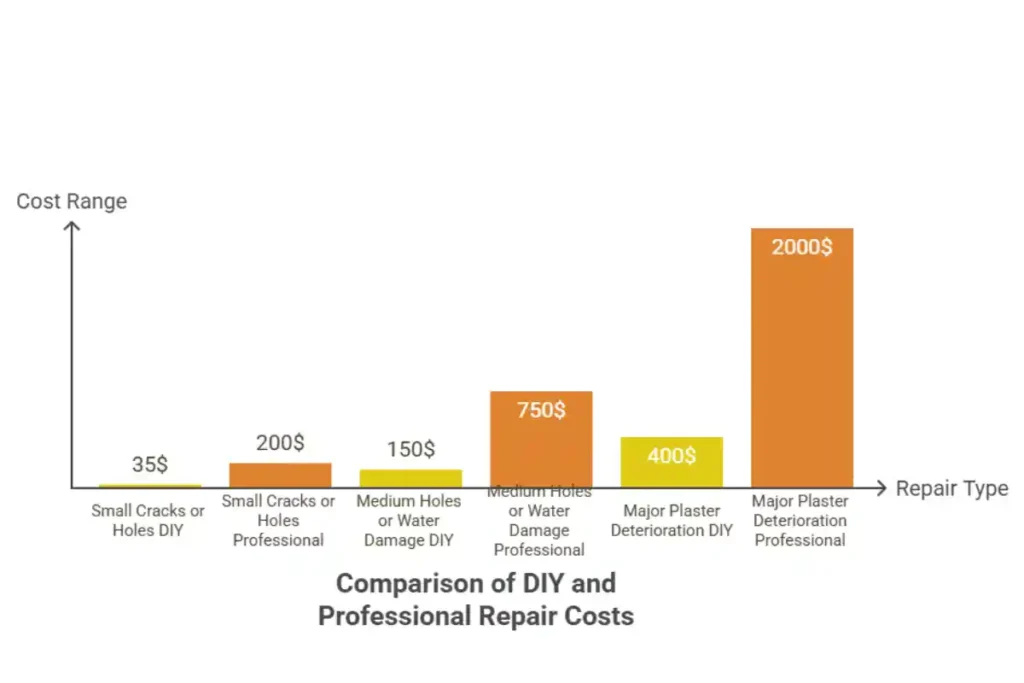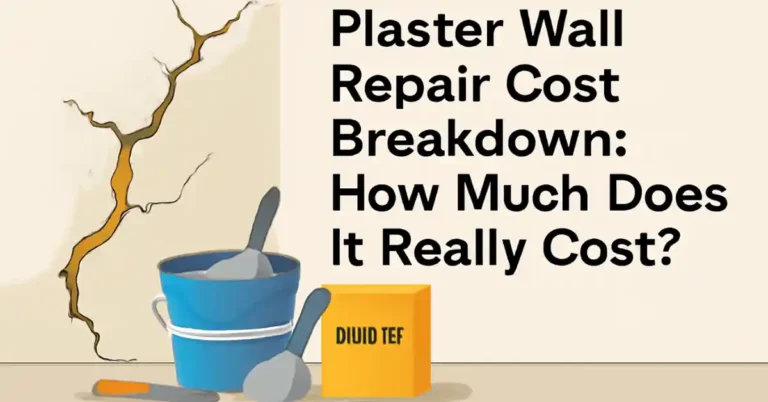Plaster Wall Repair Cost
Repairing plaster walls can seem expensive, but understanding the different costs involved can help you make informed decisions. Whether you’re repairing small cracks or larger holes, many factors influence the final cost. In this article, we’ll break down the costs associated with plaster wall repairs, considering the size of the damage, the materials required, and whether you choose to hire a professional or go the DIY route.
Table of Contents
1. Factors Influencing Plaster Wall Repair Costs
The cost of plaster wall repairs depends on several key elements. Let’s explore the main factors that influence the price:
1.1. Size and Extent of Damage
- Small Cracks and Holes: Small repairs, such as fine cracks or nail-sized holes, will cost less. They generally require fewer materials and can be completed within a few hours if you’re doing it yourself.
- Larger Holes or Deteriorating Walls: Large cavities or walls with peeling plaster may require additional materials like fiberglass mesh, and can take several days to repair, increasing the cost.
1.2. Type of Plaster Used
The type of plaster you choose can also affect the price. For example:
- Plaster of Paris: More affordable, often used for quick fixes for small holes or cracks.
- Lime Plaster: More expensive, typically used for historic homes or for repairs that need to last longer.
1.3. Professional Labor vs DIY Repairs
Hiring a professional to carry out the repairs is generally more expensive, but may be necessary for more complicated tasks like reapplying plaster to large areas or restoring historic plaster walls. DIY plaster wall repairs are cheaper but require the right skills and tools.
2. Estimating the Cost of Plaster Wall Repairs

2.1. Minor Repairs (Hairline Cracks and Small Holes)
Minor repairs like hairline cracks or small holes (nail-sized) typically cost between $50 and $150 for DIY repairs, using materials like plaster of Paris or joint compound. If you hire a professional, the cost generally increases to $150 to $250 for labor and materials.
2.2. Medium-Sized Repairs (Medium Holes)
Repairs for medium-sized holes (larger than nail holes) require multiple steps, including applying mesh reinforcement and several layers of plaster. The cost can range from $200 to $500 if done by a professional. Professionals typically charge hourly rates of $50 to $100 per hour.
2.3. Complex Repairs (Large Holes and Peeling Plaster)
For extensive repairs such as large sections of wall or plaster coming off due to moisture or age, the cost can range from $500 to $2,000 depending on the size of the area to be repaired and the complexity of the work. A professional may need to reinforce the structure, remove old plaster, and apply new layers of plaster.
3. Material Costs
The cost of materials for plaster wall repairs varies based on the quantity and type used. Here are some approximate estimates for basic materials:
- Plaster of Paris: $5 to $10 per bag, enough for small cracks or holes.
- Joint Compound (Drywall Mud): $10 to $20 for 4-5 gallons, commonly used for light plaster repairs.
- Lime Plaster: $25 to $50 per bag, used for durable repairs in older or historic homes.
- Latex Plaster Bonding Agent: $15 to $30 per liter, ensures adhesion on bare lath or porous surfaces.
- Fiberglass Mesh Tape: $10 to $15 for 25 feet, used to reinforce cracks and prevent future damage.
4. Professional Repairs vs DIY
4.1. Benefits of Professional Repairs
- Expertise: Professionals have the experience to properly assess the damage and apply the right materials for the job.
- Durability: Professional repairs usually ensure a longer-lasting result, reducing the likelihood of recurring issues.
- Time-saving: A professional can complete repairs more quickly, which is essential for larger areas or urgent repairs.
4.2. Benefits of DIY Repairs
- Cost Savings: Doing the repairs yourself can significantly reduce costs, especially for minor damage.
- Personal Satisfaction: DIY repairs can provide a sense of achievement, especially for DIY enthusiasts.
- Full Control: You control every aspect of the project, from material selection to the amount of time spent on repairs.
5. Estimated Costs for Different Repair Types
| Repair Type | DIY Cost | Professional Cost | Time to Complete |
|---|---|---|---|
| Small Cracks or Holes | $20 – $50 | $150 – $250 | 1–3 hours |
| Medium Holes or Water Damage | $100 – $200 | $500 – $1,000 | 4–8 hours |
| Major Plaster Deterioration | $300 – $500 | $1,500 – $2,500 | 1–3 days |
6. Conclusion
Plaster wall repairs can cost anywhere from a few dollars to several thousand, depending on the extent of the damage, the materials used, and whether you hire a professional or tackle the repairs yourself. If you’re handy and the damage is minimal, a DIY repair might be the best option. However, for larger or more complex repairs, it may be worth investing in a professional’s expertise.
Call-to-Action
Ready to start your plaster wall repair project? Get a detailed estimate based on your specific needs. Check out our materials and tools guide, or reach out to a professional for a comprehensive evaluation and quote.

